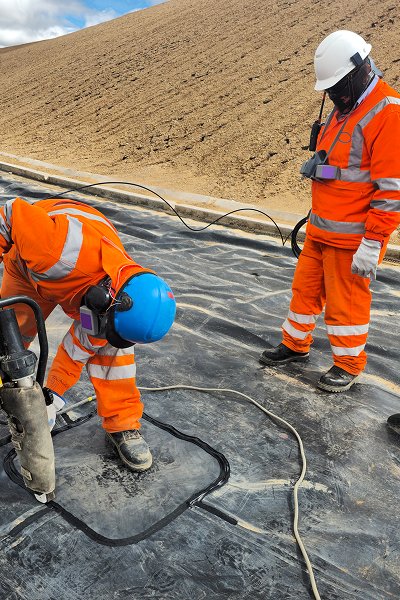HDPE characteristics:
High density (usually 0.941-0.965 g/cm³)
Excellent tensile strength
Good chemical resistance
Excellent UV resistance
Excellent low temperature resistance (can maintain toughness at -40°C)
Strong plasticity, suitable for hot melt welding
Basic characteristics of HDPE pond liner
Impermeability
HDPE pond membrane has extremely low permeability coefficient and can effectively prevent water loss. According to ASTM (American Society for Testing and Materials) standard test, the water vapor permeability of HDPE membrane is extremely low, which can achieve near zero leakage and greatly reduce the waste of water resources.
Anti-ultraviolet performance
High-quality carbon black and antioxidants are usually added to HDPE pond membrane, which significantly improves its anti-ultraviolet aging ability. Even in high temperature and high radiation areas, it can maintain stable performance and extend service life.
Chemical stability
HDPE material has strong chemical corrosion resistance and can resist the erosion of various acid, alkali and salt solutions. It is suitable for water storage needs under various water quality conditions, including agricultural irrigation water, aquaculture water and industrial wastewater containing trace chemical components.
Mechanical strength
HDPE pond membrane has high tensile strength, tear strength and puncture resistance. It can withstand a certain degree of ground subsidence, external force impact and construction machinery operation, ensuring that the pond liner can still maintain integrity in complex environments.
Low temperature resistance: HDPE pond membrane can still maintain flexibility and anti-seepage performance in the temperature range of -40℃ to 80℃, and is not prone to breakage or embrittlement due to temperature changes.


Advantages of HDPE pond liner in water storage
Excellent anti-seepage effect
Preventing water leakage is the most basic and core requirement of water storage projects. HDPE pond liner provides a protective barrier with almost "zero leakage" for ponds with its extremely low permeability. Through professional tests (such as ASTM D5887 standard test), the water vapor permeability of high-quality HDPE membrane is almost negligible. This means that under the conditions of correct construction and maintenance, the water loss in the pond will be minimized, greatly improving the efficiency and sustainability of water storage.
Especially in drought or water-scarce areas, the anti-seepage function of HDPE liner is crucial to ensure farmland irrigation and residential water use, and can effectively resist the decline of groundwater levels and the increase of water evaporation losses.
Extend the service life of water storage tanks
Compared with traditional geotechnical anti-seepage structures, such as compacted clay layers or concrete pool bottoms, HDPE pond membranes have a longer service life. High-quality HDPE pond liners can usually last for more than 20 years under outdoor exposure conditions; if used under soil cover or underwater conditions, their service life can even be extended to 30 years or more.
Adapt to various climate environments
Whether in hot desert areas, cold plateau areas, or humid tropical rainforest climates, HDPE pond membranes can work stably and show excellent environmental adaptability:
In high temperature environments, the surface of HDPE membranes can withstand temperatures above 80°C without softening or deforming.
In extremely cold environments (as low as -40°C), HDPE membranes can still maintain good flexibility and integrity and will not fail due to brittle cracking.
In humid areas with strong ultraviolet rays, HDPE membranes are added with anti-UV additives and antioxidants to effectively prevent performance degradation caused by ultraviolet radiation.
Farm irrigation pond
Agricultural irrigation requires extremely high water utilization efficiency. In order to improve water resource management capabilities, large farms decided to build two irrigation ponds with a total capacity of 20,000 cubic meters. The project used a 1.5mm thick HDPE pond membrane as an anti-seepage layer.
The anti-seepage rate increased to more than 99%, saving about 3 million gallons of water each year;
The construction period was shortened to two weeks, greatly reducing farm downtime;
No leakage or damage occurred in 5 years, and the maintenance cost was almost zero

Industrial water storage tank project
The mining company built a large industrial water storage tank with a capacity of 50,000 cubic meters. Since the water contains certain corrosive chemicals, the project selected a 2.0mm thick HDPE pond membrane with excellent chemical corrosion resistance.
Application effect:
It effectively prevents chemical liquid leakage and protects the surrounding soil and groundwater resources;
The overall structure of the pond is stable, and after years of use, the membrane is intact and undamaged;
The project successfully passed the strict acceptance standards of the environmental protection department.

How to Choose Suitable HDPE Pond Liner ?
Choose the right surface type
There are generally two types of HDPE membrane surfaces:
Glossy HDPE membrane: smooth surface, suitable for conventional water storage and anti-seepage applications;
Rough HDPE membrane: rough surface, high friction coefficient, suitable for projects with steep slopes to prevent membrane slippage.
Pay attention to the quality of raw materials
High-quality HDPE membranes are made of new virgin polyethylene particles without recycled materials. They have stable performance, slow aging and long life.
Check whether the manufacturer provides a third-party test report;
Confirm that the membrane meets international or national standards such as ASTM, GB/T.
Evaluate prices and services
Reasonable prices: extremely low quotes may mean cutting corners;
After-sales guarantee: excellent suppliers usually provide technical support and after-sales guidance services;
Customization capabilities: the ability to customize width, thickness, color, etc. according to the project helps save construction costs.


